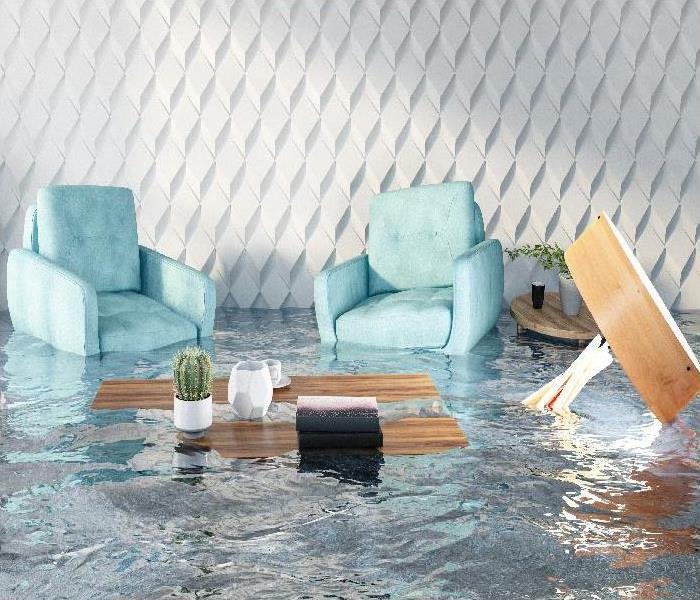What Do You Do After Your Nashua House Floods?
5/9/2020 (Permalink)
SERVPRO knows seeing your Nashua home flooded can be overwhelming, bring in professional help to make the restoration process go smoother
Floodwater in any part of your home is overwhelming to look at. One of the first actions you should take when it happens in your home is to engage a professional restoration services company.
Can Carpet with Flood Damage Get Cleaned for Reuse?
Flooring often gets the brunt of the loss when flood damage happens in a Nashua home. Once groundwater enters and saturates carpeting, in most cases, the carpet requires disposal as a biohazard due to the contaminated nature of the floodwater. Anything it runs through, it brings into the house, and sometimes the water has chemicals, debris, or sewage. Any of those elements alone make the water dangerous, and often there is a combination of those in the water. This is why SERVPRO techs wear protective clothing and use respirators to avoid aspirating the water vapor.
Signs of Water Damage to Flooring and What to Do About It
Once saturated, flooring types react in different ways to water exposure. Here are some of the most common situations that occur after an inch of floodwater enters a home:
• Floating and laminate floors - this type of floor covering tends to lose adhesion after exposure to water. SERVPRO technicians can remove the tiles and inspect the pieces to determine the nature of the construction materials. In some cases, the tiles can get cleaned, disinfected, and re-installed.
• Carpet and padding - is categorically a loss. The carpet does not have the potential to get returned to a sanitary state for reuse, and frequently the backing comes loose and causes permanent damage that is not restorable.
• Hardwood Flooring - many factors determine the outcome. For one, the amount of water exposure and also the type of composite materials that make up the flooring. Engineered hardwood with veneer topping may come loose or otherwise deteriorate. Solid hardwood floorboards may buckle or warp, but often can get dried, sanded and refinished, thereby saving the investment.
• Ceramic Tile -If the seal on the grout line is intact and the tile itself is in good shape, this type of flooring has the best potential for a full recovery. No seepage into the subfloor and no absorption of the floodwater means after extraction of the water, drying, and disinfection, the flooring stays in the home.
Proactive Actions Homeowners Can Take When Flooding Happens
If there are electrical outlets in danger of coming into contact with floodwater, turn off the electricity to the home, if it is safe to do so. If not, vacate the property and inform anyone entering the home of the potential for shock. Other efforts from homeowners that help lessen loss include:
• Removal of small items from the floor
• Take valuables out of the home
• Important documents should get removed
• Small furnishings that are easy to move should get relocated
Professional Extraction and Drying is a Must After Water Damage
SERVPRO technicians have certifications in handling biohazards and have experience dealing with the removal of contaminated floodwater safely. They can quickly extract the water and determine the migration path within the home with their advanced moisture detection equipment. This can assist in locating areas with water loss that may be outside the initial flood zone within the home, so nothing gets missed during the restoration process.
Once the techs extract the maximum amount of water, ascertained by doing "dry" passes where little to no moisture gets picked up by the equipment, they move on to the drying phase. Careful goals get set for drying times, and numerous air movers paired with dehumidifiers get deployed to bring down the moisture rapidly. The technicians carefully monitor this process to ensure the timeline gets maintained for completing this phase of the restoration.
Is It Possible to Remove Floodwater Odors By Drying?
In most situations, the odors will not diminish very much through drying. This is because the odorous molecules remain, and although the professional disinfectant and cleaning agents used by SERVPRO tech can markedly reduce musty water odors, sometimes stronger applications get used to eradicate odors fully. For airborne particles, the very safe hydroxyl generators use UV rays to eliminate odors and stop them from spreading. Thermal fogging is also a very effective way to eliminate foul scents through the use of a heated solvent delivered as a fog that penetrates items and structural elements throughout the property and makes odors a thing of the past.
SERVPRO of Nashua at (603) 889-2311 has the tools and equipment to clean up, dry, and restore local properties with flood damage. Call us as soon as possible after a water loss event for the best outcome.
For more about Nashua click here.






 24/7 Emergency Service
24/7 Emergency Service